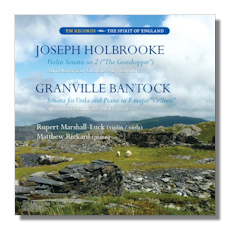
The Internet's Premier Classical Music Source
Related Links
-
Bantock Reviews
Holbrooke Reviews - Latest Reviews
- More Reviews
-
By Composer
-
Collections
DVD & Blu-ray
Books
Concert Reviews
Articles/Interviews
Software
Audio
Search Amazon
Recommended Links
Site News
 CD Review
CD Review
English Sonatas

- Joseph Holbrooke: Sonata for Violin in F Major #2 "The Grasshopper", Op. 59
- Granville Bantock: Sonata for Viola in F Major "Colleen" (1919)
Rupert Marshall-Luck, violin & viola
Matthew Rickard, piano
English Music Festival
English Music Records EMR-CD003 67:01
The two composers represented here were friends, and the two sonatas on the CD were composed the year before and the year after the Great War. Ended. Neither work reflects in the slightest the Expressionism of German music at the time, nor the conscious rejection by French composers of anything to do with the German musical tradition before that. Rather, they each suggest to me the spirit of the characteristically English advice, "Keep calm and carry on," (printed on millions of posters shortly before the Second World War, though never distributed, with only a few surviving).
Holbrooke's sonata exists also in a somewhat different concerto version, which premiered under the direction of the composer. The edition printed by Ricordi includes express indications of the differences between the two. The authorized original 1917 Version is presented here.
There appears to be no indication of where the designation "The Grasshopper" comes from, although it may seem to some that the melody does do some hopping about sometimes. Certainly the work is lively and cheerful, even jolly. The expressive instructions include more than one vivace, even vivace giocoso. The piano opens the work emphatically and is followed by quite a sweet tune on the violin. Tempos in the first movement range from allegro con molto fuoco to presto. The middle movement is slow and gently lyrical. The lightness of the final movement's mood is belied by an opening maestoso.
Holbrook's sonata is not brief, but Bantock's is emphatically long, at forty minutes, and increasingly appealing as it proceeds. Rupert Marshall-Luck, in his notes, calls it "almost symphonic in character," with motifs common to all the movements, including what he calls a three note idée fixe. The first movement is lively, with rippling piano notes against longer phrases by the violin The second movement is slow, songful and very beautiful. The finale is simply wonderful, opening with a rippling passage on the piano, continuing with the rhythm of a jig, and including a passage surely based on an English folk tune. Marshall-Luck speaks of "a boisterous, bucolic, Breugelian dance." The commentary also points out that three different themes, with different rhythms, all begin with the same notes.
Generally the piano in these has much to say on its own. Only in the middle movement of the Holbrooke did I particularly notice the piano simply reinforcing the violin. The differing utterances of the separate instruments unquestionably add to the interest and appeal of these quintessentially English works. This is a world-premiere recording and is performed on Gustav Holst's viola.
Highly recommended.
Copyright © 2015, R. James Tobin





















